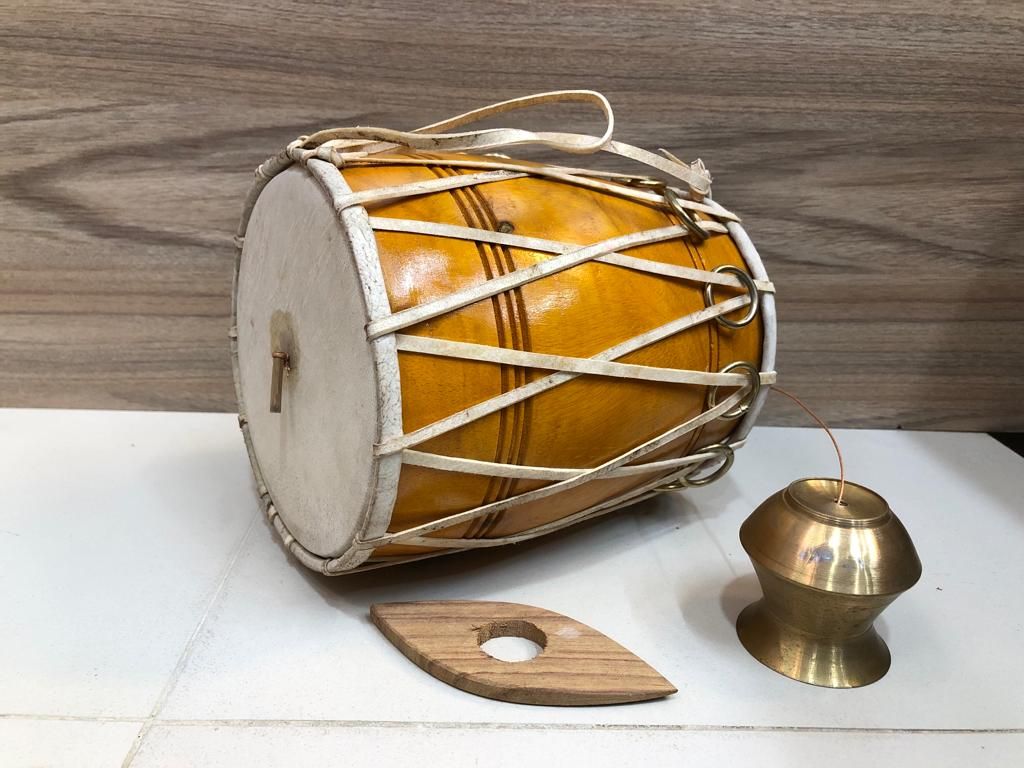Khamak
Melodic Percussions
Asia
Between 1001 and 1900 AD
Video
The Khamak is a unique string instrument that holds a significant place in the folk music traditions of India, particularly in the regions of Bengal, Odisha, and Northeast India. Characterized by its simple yet effective design, the Khamak consists of a wooden bowl that serves as its body and a single string that is plucked to produce sound.
Unlike similar instruments such as the Ektara, the Khamak does not utilize bamboo for its structure, making it distinct in both appearance and sound production. The instrument is typically played during folk songs, especially Baul music, where it adds a rhythmic and melodic layer to the performance. The Khamak is classified as a stringed percussion instrument. It combines elements of both string and percussion instruments, allowing musicians to create a variety of sounds by plucking the string while simultaneously adjusting its tension. This dual functionality enables the Khamak to produce both melodic and rhythmic components, making it versatile in various musical contexts.
History
The khamak finds its origins in the Indian subcontinent, particularly in the Bengal region, which includes parts of present-day India and Bangladesh. The instrument is deeply intertwined with the folk traditions of Bengal, where it has been used for centuries by wandering minstrels known as Bauls. These mystic musicians employed the khamak to complement their soulful, philosophical songs. The exact century of the khamak’s origin is difficult to pinpoint due to the oral traditions of folk music, but it is believed to have emerged during the medieval period. It became a prominent part of Baul culture between the 16th and 18th centuries. Over time, the instrument gained recognition in other forms of folk and classical music, ensuring its enduring legacy.
Construction
The khamak is a simple yet ingenious instrument. It consists of a small drum, often crafted from wood or coconut shells, serving as the resonator. The top of the drum is covered with animal hide or synthetic material, similar to a drumhead. A string is attached to the drumhead, with the other end tied to a stick or wooden handle. This string is adjustable, allowing the player to alter the tension and, consequently, the pitch of the sound. The materials used for constructing a khamak are often locally sourced, making the instrument accessible and affordable. The simplicity of its design does not compromise its capability to produce rich, resonant tones that captivate listeners.
Types of Khamak
Traditional Khamak: Made from natural materials like wood, coconut shells, and animal hide, this type is commonly used in Baul music and rural settings.
Modern Khamak: Incorporates synthetic materials for durability and is often used in contemporary and fusion music.
Miniature Khamak: A smaller version designed for portability, often used by traveling performers.
Decorative Khamak: Enhanced with ornate designs for use in ceremonial or decorative contexts.
Features
Hybrid Design: Combines elements of string and percussion instruments.
Portable: Lightweight and easy to carry, making it ideal for wandering musicians.
Tonal Flexibility: The adjustable string allows for a wide range of pitches.
Expressive Sound: Produces a dynamic sound that complements vocal performances.
Cultural Symbolism: Represents the spiritual and philosophical ethos of Baul traditions.
Sound Production
The khamak produces sound through a combination of string vibration and drum resonance. When the player pulls and releases the string, it vibrates, creating a distinct tonal quality. Simultaneously, the vibrations resonate within the drum, amplifying the sound. The player can manipulate the pitch and intensity by adjusting the string tension and varying the force of their pull. This interplay of tension and resonance creates the khamak’s characteristic sound, which is both rhythmic and melodic.
Playing Methods
The khamak is typically played while seated. The drum is held against the player’s body or placed on the ground, and the string is plucked or pulled using one hand, while the other stabilizes the instrument. The player uses a combination of finger movements and wrist techniques to create rhythmic patterns and melodic phrases. Skilled players can produce intricate sounds by varying the string’s tension, often synchronizing their performance with vocal or instrumental accompaniments.
Roles in Music
The khamak plays a vital role in various musical genres, particularly:
Baul Music: As a quintessential instrument of the Bauls, the khamak accompanies their soulful, philosophical songs, enhancing the emotive quality of their performances.
Folk Music: It is widely used in folk traditions across Bengal and neighboring regions, adding a rhythmic and melodic layer to ensembles.
Fusion Music: In contemporary music, the khamak has found a place in fusion genres, blending traditional sounds with modern instrumentation.
Religious and Ceremonial Contexts: The instrument is often played during spiritual gatherings and cultural festivals, symbolizing the unity of rhythm and melody in human expression.
The khamak is more than just a musical instrument; it is a cultural icon that embodies the spirit of Bengal’s folk traditions. Its unique construction, captivating sound, and versatility have ensured its relevance across centuries. From the mystic songs of Bauls to contemporary fusion music, the khamak continues to inspire and captivate audiences, proving that its charm is timeless
FAQ
What is the significance of the Khamak in Indian folk music?
The Khamak holds significant cultural importance as it enriches folk music traditions across India. It serves as an accompaniment for vocal performances, particularly in Baul music, allowing musicians to express deep emotional narratives through sound.
What are the origins of the Khamak?
The origins of the Khamak can be traced back several centuries within India, particularly in Bengal and surrounding regions. It has evolved from ancient musical practices into an essential component of contemporary folk music.
How is the Khamak constructed?
The construction of the Khamak involves crafting a wooden bowl connected by a single plucked string. Artisans use traditional methods to ensure each instrument resonates uniquely while maintaining its fundamental design.
 Links
Links
References
Other Instrument
Categories


















